Becker W. Advanced Time-Correlated Single Photon Counting Techniques
Подождите немного. Документ загружается.

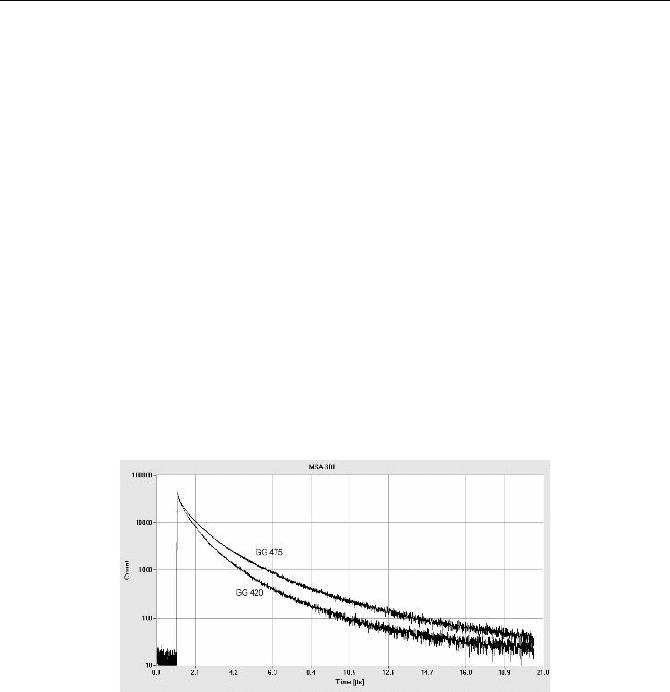
7.2 Optical Systems 275
The most important absorptive short-pass filter is the BG 39, which has a
blocking factor of more than 10
5
between 800 nm and 1,000 nm. It is used to
block the NIR laser in experiments with two-photon excitation. Even blocking
filters of the interference type for two-photon microscopy sometimes use a BG 39
substrate.
Compared to interference filters (see paragraph below), the transition between
the stopband and the passband of absorptive filters is not very steep. However,
long-pass absorptive filters have high blocking factors below the stopband wave-
length and high transmission above the passband wavelength. An advantage in
TCSPC applications is that the light in the stopband is absorbed and not reflected
back into the beam path. Moreover, the filters work well if they are placed in an
uncollimated (convergent or divergent) beam. The cut-off may shift a bit to a
longer wavelength due to the longer path length for oblique rays, but the general
performance remains unchanged.
A problem of absorptive filters in TCSPC applications can be fluorescence of
the filter glass. The lifetimes of filter fluorescence can be anywhere between a
nanosecond and tens of microseconds. Figure 7.13 shows the fluorescence decay
of a GG 420 and a GG 475 filter.
Fig. 7.13 Fluorescence decay of GG 420 and GG 475 filter glasses. Time scale 2.1 µs per
division, intensity scale logarithmic, 1 decade per division. Excitation at 368 nm
The filters were illuminated at 368 nm by 100-ns pulses from a 370 nm LED. A
368-nm interference filter was used to block LED emissions above 380 nm. The
filter emission was recorded by a Becker & Hickl PMC
100 detector and a
MSA
300 multiscaler. The decay is multiexponential with lifetime components
from about 500 ns to several microseconds.
Filter glasses of the same type can show totally different fluorescence intensi-
ties and decay profiles. Figure 7.14, left, shows fluorescence decay curves of two
GG 435 filters in the microsecond range. Figure 7.14, right, shows the fluores-
cence of filter 2 (the less fluorescent one) on the nanosecond scale. The curve was
recorded by TCSPC with excitation by a 372 nm, 50 MHz picosecond diode laser.
It shows a fluorescence component of about 2 ns lifetime on the background of
slow fluorescence.
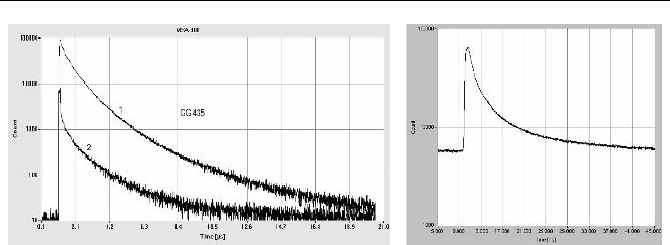
276 7 Practice of TCSPC Experiments
Fig. 7.14 Fluorescence of different samples of GG 435 filter glasses. Left: 2.1 µs/div, re-
corded by a multiscaler. Right: Sample 2, recorded by TCSPC, 4 ns/div
If the lifetime of the filter fluorescence is long, the result is an apparent increase
in the background count rate, which is often mistaken for detector background or
leakage of daylight. Absorptive filters should be checked for possible lumines-
cence and, if possible, should be placed far away from any image plane conju-
gated with the detector.
Interference Filters
Interference filters are made by depositing a series of dielectric and metallic layers
on a glass substrate. In addition to these layers, the interference filters often have
an absorptive layer on one or both sides to block residual transmission in the stop-
band. A wide variety of filter characteristics are available – short-pass, long-pass,
band-pass, narrowband and notch filters. Interference filters can be made with
steep transition between the stopband and the passband. The transmission in the
passband varies from about 30% for narrow band filters to almost 100% for short-
pass, long-pass, and notch filters. Interference filters are almost ideal to block
excitation light or daylight, and to select a detection wavelength interval. How-
ever, interference filters work at their specified performance only if they are
placed under 90° in a parallel beam. For oblique beams the transmission wave-
length shifts to shorter wavelength. The shift is considerable, as you can see by
looking through a tilted narrowband filter. This implies that the full performance
of interference filters can be exploited only in a collimated beam. For light emitted
from a small sample area, collimation can easily be achieved by an appropriate
relay lens system. However, if the light is emitted from a large area, a near-
parallel beam can only be obtained by a transfer lens system of a focal length
larger than the emitting area, see Fig. 7.15. Problems can also arise from stray-
light. Straylight can pass the filter at any angle from the optical axis, with a corre-
spondingly large change in the filter characteristic.

7.2 Optical Systems 277
Source
of
Emission
Lens LensFilter
Detector
Source
of
Emission
Lens LensFilter
Detector
Fig. 7.15 An interference filter must be placed in a parallel beam. This is no problem if the
emission comes from a point-source (left). If the emission comes from a larger area (right),
it is necessary to make a tradeoff between the size of the relay lens system and the tilt angle
An important feature of interference filters is that the blocked light is reflected
back into the beam path. Because the filter is placed in a collimated beam, the re-
flected light is perfectly focused back into the sample. This can cause noticeable
afterpulses in the IRF of a TCSPC system. The remedy is often to use an additional
coloured glass filter in front of the interference filter. If the filter has an additional
absorptive layer on one side, this side should be oriented toward the light source.
For the same reasons interference filters should not be stacked. The reflected
light bounces between the filters (see Fig. 7.27). The result is pulse distortion, and
a stopband attenuation smaller than the product of the attenuation of the individual
filters.
Linear-variable interference filters have a transmission wavelength that varies
linearly over the length of the filter. In the visible range the bandwidth is 10 to
20 nm and the transmission about 40%. The filters can be used as simple mono-
chromators. A linear variable interference filter placed in front of a multichannel
PMT makes a simple multispectral detection system. However, the efficiency of
such a system is low, because most of the photons are blocked by the filter.
Neutral-Density Filters
Neutral density (or ND) filters can be made of a metal layer deposited on a glass
surface, a plate of absorptive glass, or a photographic plate or another gelatine
layer containing a colloidal absorber. Metal filters can withstand high incident
power. They are therefore suitable to attenuate a high-power laser beam. However,
light that is not transmitted is reflected back to the source. Reflecting light back
into a laser can cause problems. Reflection can also cause afterpulses in the IRF of
a TCSPC system. Metal filters should not be stacked, because the light bounces
between the filters. For the ultraviolet range, metal filters on fused-silica sub-
strates are available.
Absorptive glass filters do not reflect much light and are therefore the best solu-
tion for the detection light path of a TCSPC system. The absorption is wavelength-
dependent, especially in the NUV and NIR. Absorptive ND filters often lose trans-
parency below 350 nm, and in the IR the transmission can be higher or lower than
in the visible range. Transmission curves of commonly used neutral density filter
glasses are shown in Fig. 7.16.
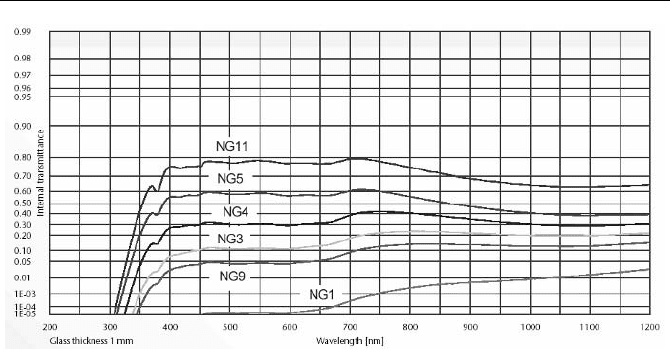
278 7 Practice of TCSPC Experiments
Fig. 7.16 Transmission curves of ND filters. [447], Courtesy of Schott, Germany
A commonly ignored effect is the dependence of the absorption on the beam
angle. An oblique beam takes a longer path through the filter and, consequently,
experiences higher absorption than a beam parallel to the optical axis. If an ND
filter is placed in a convergent or divergent beam, it can change the effective NA
of the system.
Absorptive ND filters can emit some fluorescence. The intensity is normally
very low and normally not objectionable.
Continuously variable attenuation is provided by variable ND filters. Early
variable ND filters were made of two cemented wedges of glass, one of which was
absorptive. The filters had low reflection, low scattering, and good optical quality.
However, because of their high price and low tolerance of high power levels, they
are no longer used. Modern variable ND filters are either graded metal filters or
gelatine filters.
7.2.3 Beam Splitters
Wavelength-Independent Beam Splitters
Cube beam splitters are made of a pairs of right angle prisms with their hypote-
nuse faces cemented together. A partially reflecting metal or dielectric layer is
deposited on one of the faces. Cube beam splitters are rugged and possess good
long-term stability. Reflections from the side planes of the cube are sometimes
objectionable (see Fig. 5.106, page 175). Placing the cube in a convergent or di-
vergent portion of a beam path changes the spherical correction of the system.
Plate beam splitters are glass plates with a partially reflecting layer on one
plane. Reflections from the other plane can be cause ghosts in imaging systems.
Such reflections are avoided in pellicle beam splitters. Pellicle beam splitters con-
sist of a nitrocellulose membrane with a partially reflective coating. They are
difficult to handle and their long-term stability is questionable.
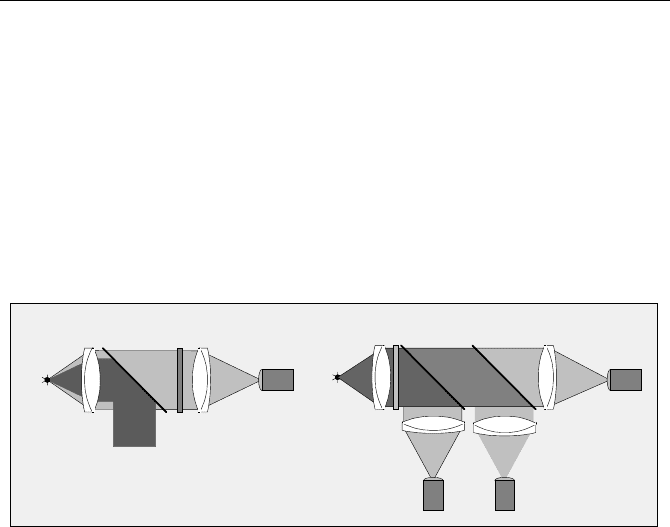
7.2 Optical Systems 279
Dichroic Beam Splitters
Dichroic beam splitters (or filters) use the same principle as interference filters.
They are placed in a collimated beam, typically at a 45-degree angle. There are
long-pass, short-pass and bandpass versions. They are extremely suitable for
building high-efficiency optical systems. Figure 7.17, left, shows how a laser is
coupled into a high-NA fluorescence excitation and detection system.
Figure 7.17, right, shows a system that splits a fluorescence signal into several
wavelength intervals. The signals in these intervals are detected by individual
detectors and recorded simultaneously either in one TCSPC channel with a router,
or in a multimodule TCSPC system.
Filter
Detector
Laser
Dichroic
Beam Splitter
Excited
spot
of
sample
Detector 3
Dichroic
Beam Splitters
Excited
spot
of
sample
Detector 1 Detector 2
Filter
Lens Lens
Lens Lens
Lens Lens
Fig. 7.17 Use of dichroic beam splitters in high-efficiency optical systems. Left: Coupling a
laser into a high NA fluorescence system. Right: Splitting fluorescence light into several
wavelength channels for simultaneous detection with individual PMTs
Polarising Beam Splitters
Polarising beam splitters are cubes made of two cemented right-angle prisms with
a dielectric coating on the hypotenuse. They work only in a limited wavelength
range, typically 50 to 200 nm. If the limited wavelength range is acceptable they
can efficiently split the polarisation components of fluorescence anisotropy meas-
urements.
7.2.4 Monochromators and Polychromators
The general principle of a grating monochromator is shown in Fig. 7.18. The light
passes an input slit, is collimated by a mirror or a lens, and is diffracted by the
grating. The angle of diffraction depends on the wavelength. A second mirror or
lens focuses the diffracted light into the plane of the output slit, generating a spec-
trum of the input light. The output slit transmits a narrow portion of the spectrum.
The wavelength transmitted is changed by rotating the grating. A large number of
different monochromator configurations exist, but the general principle is the
same.
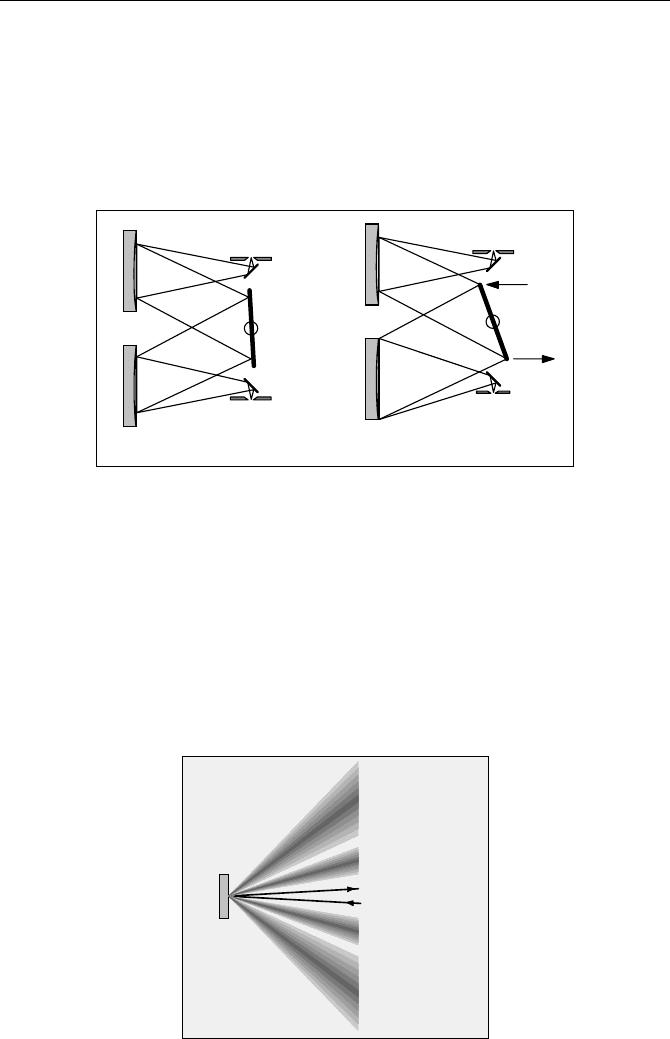
280 7 Practice of TCSPC Experiments
A problem of monochromators in picosecond-spectroscopy applications is col-
our shift and pulse dispersion. The path length from the entrance slit to the grating
and from the grating to the exit slit is different for both sides of the grating. The
path length difference depends on the angle of the grating, i.e. on the selected
wavelength. Therefore a pulse travelling through the monochromator broadens. It
may even shift in time if the optical axis is not perfectly aligned. The problem is
illustrated in Fig. 7.18.
Grating
Slit
Slit
Mirror
Mirror
Mirror
Mirror
Grating
Slit
Slit
Wavelength 1 Wavelength 2
Fig. 7.18 Wavelength-dependent path length in a monochromator
Pulse dispersion and pulse shift can be avoided by using a double monochro-
mator of the „subtractive dispersion“ type. In this design the second monochroma-
tor is turned 180 °, and the gratings are moving in opposite directions. Thus the
path length differences for both sides of the gratings and for different wavelength
cancel.
A second problem of monochromators is their relatively low efficiency. Most
of the currently available monochromators use a grating as a dispersive element. A
grating diffracts the light into multiple diffraction orders on either side of the inci-
dent beam, see Fig. 7.19.
Grating
Incident light
Zero order
First order
Second order
(specular reflection)
diffraction
diffraction
First order
diffraction
Second order
diffraction
Fig. 7.19 Diffraction orders of a grating

7.2 Optical Systems 281
Ruled gratings have sawtooth-shaped grooves and diffract 40 to 80% into the
first order on one side of the incident beam. The rest of the light is reflected in the
zero order or diffracted into higher orders and into the first order on the other side
of the incident beam. This can result in a number of unpleasant effects.
The unused light can cause considerable straylight problems, and the second
diffraction order may overlap with the first one. In TCSPC applications, grating
monochromators or polychromators should therefore always be used with a filter
that blocks the excitation wavelength.
Moreover, the fraction of the light diffracted into the first order depends on the
wavelength. If a grating monochromator or polychromator is used to record a
spectrum, the wavelength dependence of the efficiency needs to be calibrated. The
diffraction efficiency of a grating also depends on the polarisation of the light.
The benefit of the grating monochromator is that it can be built with high
f numbers. F numbers around f:3.5 are common, and f:2 can be achieved with
some tradeoff in resolution. The high f numbers often compensate for the less than
ideal efficiency of the grating.
Most of the unpleasant effects of a grating are avoided in prism monochroma-
tors. In principle, a prism can achieve almost 100% efficiency. The dispersion of a
prism is nonlinear, but approximately proportional to the wave number. This is
often considered a drawback of the prism monochromator. More important it is
certainly that the low dispersion of a prism causes geometric constraints and pre-
cludes the use of f numbers much faster than f : 8. In fluorescence spectroscopy,
prism monochromators have fallen almost entirely out of use.
By definition, a monochromator transmits only a narrow part of the input spec-
trum. A spectrum of the input signal is obtained by scanning the wavelength. Con-
sequently, most of the signal photons are blocked, and the efficiency is low. Pho-
ton loss can be avoided by using a polychromator or spectrograph. These
instruments use the same principle as a monochromator but have no output slit.
They therefore deliver the whole spectrum of the input light in their output image
plane. Some monochromators have removable output slits and can be used as
monochromators or polychromators. In a multiwavelength TCSPC setup, a mul-
tianode PMT or position-sensitive PMT is placed in the output image plane of the
polychromator. The photons of the detector channels are routed into different
memory blocks of a single TCSPC module.
Compared to scanning of a spectrum by a monochromator, a polychromator
with a multianode PMT system is more efficient at recording a spectrum; the de-
gree of its relative efficiency is proportional to the number of PMT channels.
To obtain maximum light throughput, the f number of the input light cone must
match the f number of the monochromator. Moreover, the image in the input plane
must not be larger than the slit. Building an appropriate relay lens system is no
problem if the light comes from a point source. For larger sources the throughput
is limited by the slit size and the f number of the monochromator; see Fig. 7.20.
Once the input light cone matches the f number of the monochromator
(Fig. 7.20a), neither (b) a larger lens nor (c) a lens with a higher NA at the source
side will increase the amount of transmitted light. Case (b) leads to an input cone
of a larger f number than accepted by the monochromator. Case (c) results in an
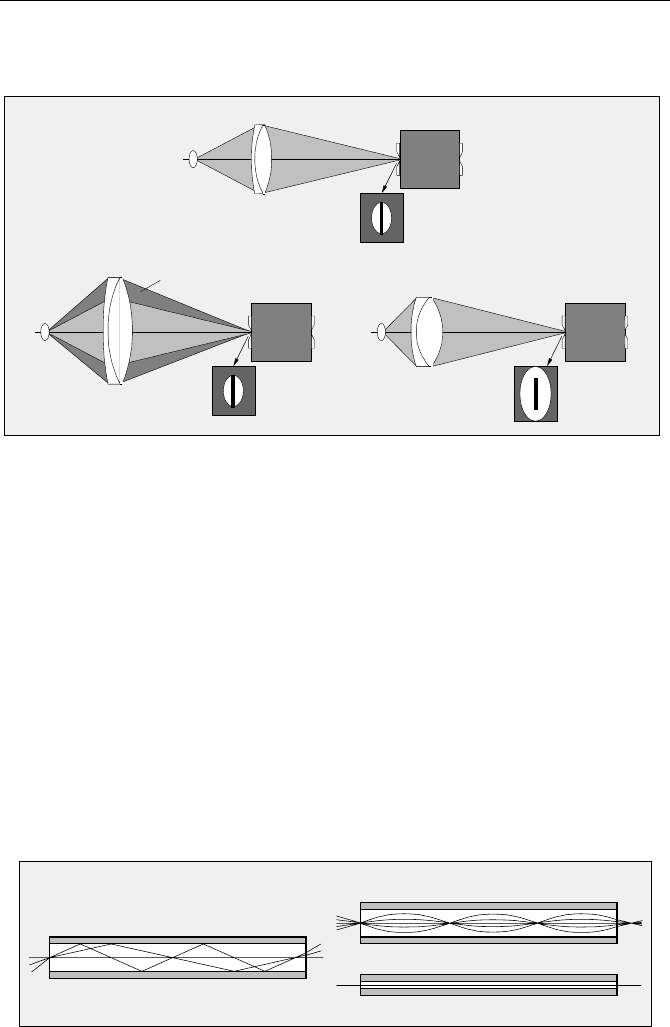
282 7 Practice of TCSPC Experiments
image larger than the monochromator slit. In both cases the additional light trans-
ferred by the lens is not transmitted through the monochromator.
Source
of
Emission
Lens
Monochromator, f / n
f / n
Source
of
Emission
Lens
Monochromator, f / n
f / n
Image on
monochromator
slit
Image on
slit
monochromator
Source
of
Emission
Lens
Monochromator, f / n
f / n
Image on
monochromator
slit
> f / n
a) f number matched
slit fully illuminated
b)
f number too high
slit fully illuminated, but
c) f number matched, but
slit over-illuminated
unused
used
Fig. 7.20 Limitations of the light throughput of a monochromator. Once the slit is fully
illuminated and the f numbers are equal, neither (a) a larger lens nor (b) a lens with a higher
NA at the source side will increase the throughput
The only way to improve the efficiency is to reduce the size of the excited spot
in the sample or to match the shape of the source spot to the monochromator slit.
In cuvette fluorescence systems with a horizontal excitation beam, a large im-
provement can be made by turning the monochromator 90°, so that the slit is hori-
zontal and matches the orientation of the excited sample volume.
7.2.5 Optical Fibres
Optical fibres are convenient for sending light from one place to another. Once the
light is coupled into one end of a fibre it arrives at the other, regardless of how the
fibre is bent or moved. Optical fibres come in three versions – multimode fibres,
gradient-index fibres, and single-mode fibres (Fig. 7.21).
Multi-Mode Fibre
Single-Mode Fibre
Gradient-Index Fibre
Fig. 7.21 Light propagation in a multimode fibre, a gradient-index fibre, and a single-mode
fibre

7.2 Optical Systems 283
Multimode fibres consist of a core with a high index of refraction and a clad-
ding with a lower index of refraction. The light is kept inside the fibre by total
internal reflection. The fibres accept relatively large beam angles. Therefore mul-
timode fibres can be used at an NA of up to 0.4. Multimode fibres made of glass
and fused silica fibres come in diameters up to 1.5 mm, plastic fibres up to 3 mm.
To increase the cross section further, a large number of fibres can be combined
into a fibre bundle.
The large diameter makes it relatively easy to couple light into a multimode fi-
bre. However, rays of different angles to the optical axis have different optical
path lengths and, consequently, different transit times. Therefore, a light pulse
coupled into the fibre at an NA greater than zero spreads out in time. The transit
time spread – or pulse dispersion – increases with the length of the fibre and with
the NA of the input beam. It does not depend on the thickness of the fibre. A for-
mula for the pulse dispersion is given in [326]. The impulse response of the fibre
is roughly rectangular and has a width,
't, of
¸
¸
¹
·
¨
¨
©
§
'
1
/1
1
22
nNA
c
nl
t
(7.4)
with
n = refractive index of fibre core, l = length of fibre, c = vacuum velocity of
light,
NA numerical aperture [326].
Gradient-index fibres have a gradient in the index of refraction from the centre
to the periphery. The light is kept inside the fibre by refraction. Therefore, the
geometric path length difference is compensated for by the different speed of light
at different distance from the centre. Consequently there is no transit time spread
and no pulse dispersion. The downside is that the maximum NA is smaller than
for the multimode fibres. Moreover, gradient index fibres come in small diameters
of 50 to 100 µm only. Unless the input beam quality is very good, the throughput
is smaller than for a multimode fibre.
The number of wave modes that can propagate through a fibre depends on the
core diameter and the wavelength. If the core diameter is made extremely small,
only the zero-order mode is transmitted. This mode goes straight through the fibre
without reflections at the side walls. Consequently, there is no transit time spread
and no pulse dispersion. However, the core diameter is only 3 to 10 µm, which
makes it very difficult to couple light into the fibre with high efficiency. Good
coupling efficiency can be obtained for gas lasers or solid state lasers that deliver a
high beam quality. To obtain an acceptable coupling efficiency for diode lasers,
the astigmatism of the beam has to be corrected and the cross-section has to be
shaped by anamorphic optics. An anamorphic system has different magnification
in the horizontal and vertical directions. It can be made by cylinder lenses or
prisms. Coupling fluorescence light or other signals from macroscopic samples
into single-mode fibres is an almost hopeless enterprise.
Due to their high throughput capability, multimode fibres are frequently used to
transmit light in optical systems for TCSPC. Figure 7.22 shows how NA and pulse
dispersion can be traded against fibre diameter.
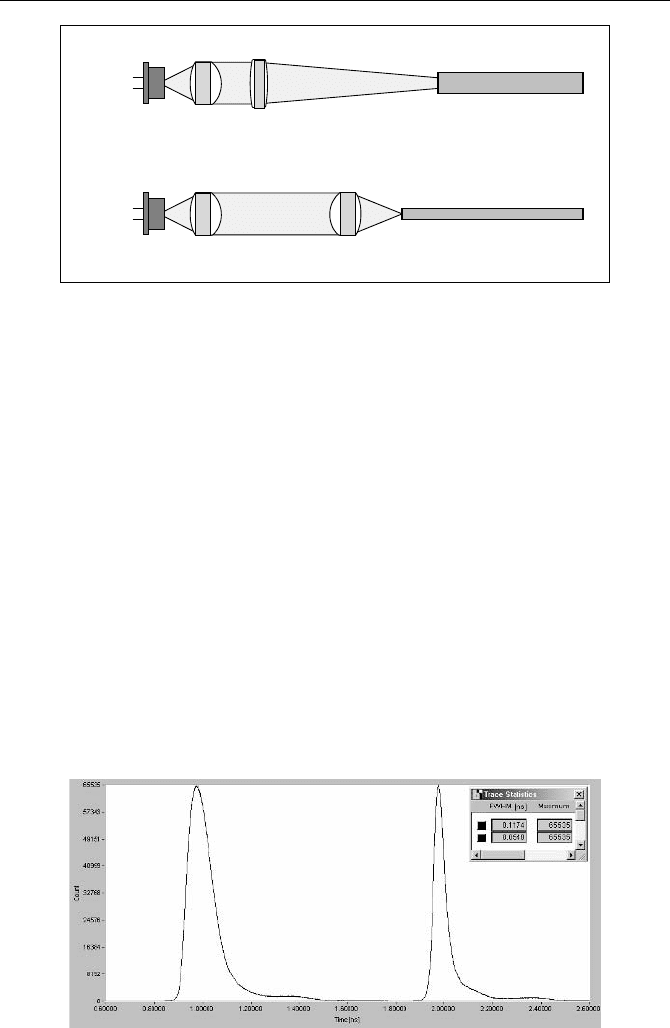
284 7 Practice of TCSPC Experiments
f1 f2 >> f1
f1 f1
Fibre
Fibre
Source
Collimator
Lens 1 Lens 2
Collimator
Lens 1 Lens 2
Laser
diode
Laser
diode
M = f2 / f1
NA = NA f1/f2
laser
.
Collimator
low NA
low pulse dispersion
large fibre diamater
high NA
high pulse dispersion
small fibre diameter
Fig. 7.22 Trading NA against fibre diameter when coupling a diode laser into a fibre
The light from the source, in this case a laser diode, is transferred to the fibre
input cross section by a transfer lens system. The first lens is the laser collimator,
with a focal length, f1, which is normally a few mm. If the collimated beam is
focused into a fibre by a lens of a longer focal length, f2, all aberrations in the
laser beam profile are magnified by a factor M = f2 / f1. This requires a fibre of a
correspondingly large diameter. However, the NA of the beam coupled into the
fibre, and consequently the pulse dispersion in the fibre, is reduced by the same
ratio.
If a lens of short focal length is used, e.g. a second laser diode collimator, mag-
nification of the aberrations is avoided. Now the laser can be coupled into a thin
fibre. However, the NA is large, and so is the pulse dispersion. An example is
shown in Fig. 7.23. Pulses from a 650 nm, 45 ps diode laser were sent through a
1 mm fibre of 2 m length. The pulse shape shown left is for an NA of 0.3, the right
pulse shape is for an NA of < 0.1.
In all cases when multimode fibres or fibre bundles are used, care must be
taken that the effective NA of the light cones remains constant at the input and the
output. The most objectionable design is an iris diaphragm for intensity regulation
in front of a fibre. However, the transmission of neutral-density filters, colour
Fig. 7.23 Pulse dispersion in a multimode fibre of 1 mm diameter and 2 m length. The
pulses of a 650 nm, 45
p
s diode laser were sent through the fibre and detected by an
R3809U MCP PMT. Left: NA = 0.3, fwhm = 117 ps. Right: NA < 0.1, fwhm = 54 ps
